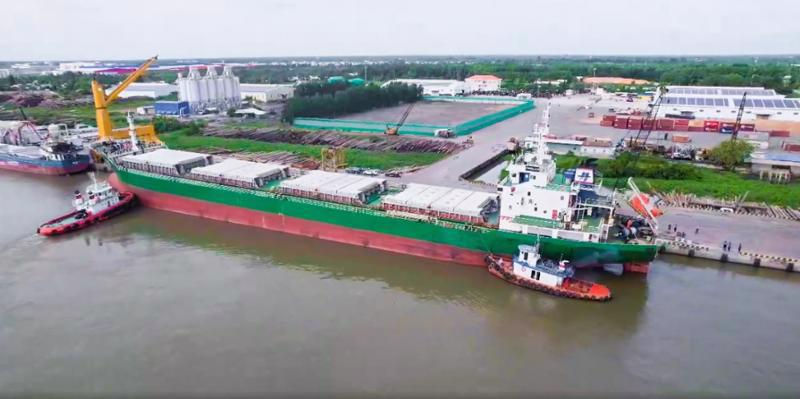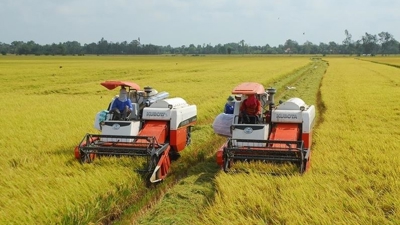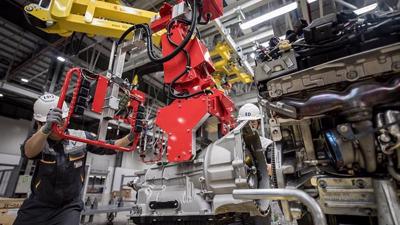In response to global trade tensions'
Ongoing global trade tensions call for Vietnam to be ready for any eventuality and to look closer at its own backyard.

While recent trade tensions between the US and China have cooled somewhat, President Donald Trump may still shift tactics. His overarching goal of reshaping the global monetary and trade order, however, remains steadfast. For this reason, Vietnam must remain agile and be ready to adapt to unexpected shifts that could impact monetary policy and pose risks to asset markets.
Experts largely agree that the root cause of the global trade war, sparked by President Trump, is his desire to revitalize US manufacturing while strategically weakening the USD against other currencies.
Vietnam in the crosshairs
Analysts have warned that the trade war has had far-reaching consequences for the global economy, particularly for emerging markets like Vietnam, where economic fundamentals are still developing.
First, Trump’s trade war 2.0 is reshaping globalization. Countries are moving away from multilateral cooperation and leaning towards bilateral agreements that prioritize national interests.
Second, as the US brings manufacturing back onshore, other developed economies may lose incentives to invest abroad. This could trigger a wave of reshoring, with countries focusing more on protecting domestic jobs and industries.
Third, to support export competitiveness, the Trump administration favors a weaker USD against other currencies. For Vietnam, this could be a “double-edged sword”. A weaker USD would help Vietnamese importers, but exporters may face losses. Additionally, Vietnam could risk being labeled a currency manipulator if it is seen as using exchange rates to boost exports, potentially increasing its foreign debt burden.
Fourth, the trade war emerged amid overheated financial markets in the US, the EU, and China, raising concerns over asset bubbles. For emerging markets like Vietnam, the risk is greater if foreign capital such as FDI and foreign indirect investment (FII) begins to be withdrawn. In the US, hedge funds are exposed to risks stemming from financial leverage and derivative products. However, if capital quickly returns to the US and shifts toward real economic activity, asset bubbles might deflate gently rather than burst. Meanwhile, industrial real estate in key US states could recover, supported by renewed manufacturing, forming a new foundation for economic stability.
Just days after announcing high reciprocal tariffs on products from hundreds of countries, the US paused these measures for 90 days to allow for negotiations, including with Vietnam. On May 12 (Vietnam time), the US and China then announced a 90-day truce to negotiate new tariff terms. Though tensions have temporarily eased, experts stress that President Trump may shift his tactics at any time. However, his ultimate objective - to restructure the global monetary and trade order - remains unchanged. That’s why Vietnam must always be prepared with multiple response scenarios to deal with sudden shifts in monetary policy and external risks.
Caught in a vise
At the recent “US Reciprocal Tariff Policy: Impacts and Strategic Adjustments for Vietnam” seminar, hosted by the National Economics University, Dr. Tran Toan Thang, Head of the International Issues Division at the National Institute for Economics and Finance under the Ministry of Finance (MoF), emphasized that the State Bank of Vietnam (SBV) must carefully assess and anticipate the risks posed by a weakening USD. “In the near future, regulators must brace for the depreciation of the USD, which will have far-reaching implications for Vietnam, from exports and imports to foreign investment and inflation,” he warned.
Dr. Le Xuan Sang, Deputy Director of the Vietnam Institute of Economics, raised concerns about escalating trade tensions potentially spiraling into a currency war, putting Vietnam in a “pincer position” between two major powers and its top trading partners.
On the upside, he also noted that the influx of low-cost Chinese goods into Vietnam could intensify competition for domestic products but would also help reduce consumer prices and ease inflationary pressure. This, in turn, may allow the SBV to maintain a low interest rate environment to support economic growth. However, another tactic China might use to offset US tariffs is to devalue the Yuan.
According to experts, simultaneous depreciation of the USD and the Yuan would pressure Vietnam to weaken the VND to remain export-competitive. But a sharp devaluation could backfire, by inflating public debt (as foreign currency-denominated liabilities grow), stoking imported inflation and increasing the risk of being labeled a currency manipulator by the US.
In short, trade tensions have forced the SBV into a challenging balancing act as it seeks to fulfill multiple objectives in its monetary policy: (1) support exports, (2) contain imported inflation, (3) attract and retain foreign capital flows, and (4) maintain policy credibility and transparency to avoid being placed on the currency manipulation watchlist.
Urgent reforms needed
Analysts believe that now more than ever, the MoF and the SBV must coordinate closely to initiate a true restructuring of the financial market, restoring investor confidence and ensuring Vietnam remains an appealing destination for international capital. In the short term, targeted support for key sectors, especially manufacturing businesses impacted by trade tensions, will help stabilize market sentiment.
Associate Professor Phan Huu Nghi from the National Economics University emphasized that government support is essential to maintain the 8 per cent GDP growth target for 2025 and beyond. He noted that support measures should be sufficiently substantial to offset losses caused by new tariffs. The MoF has introduced tax relief through decrees, and additional proposals include a 30 per cent cut in corporate income tax for companies with annual revenues under VND200 billion ($8 million), a 30 per cent reduction in land lease fees, lowered administrative charges, and a review of “domestic export” policies. Medium-term preferential credit packages are also under consideration. However, implementation must comply with international trade obligations, particularly transparency and anti-subsidy rules in strategic industries.
Experts also urge authorities to prepare for potential financial crises, including defaults, banking liquidity risks, and asset price shocks. Vietnam must audit its financial buffers and ensure clear rescue strategies are in place. At the same time, monetary policy should aim to stabilize the VND exchange rate to avoid exacerbating trade war effects through a sharp devaluation against the USD.
To attract long-term capital, analysts recommend lifting foreign ownership caps and removing policy barriers discouraging institutional investors. Vietnam’s financial market requires urgent reform to ensure stability, transparency, and sustainability, with the protection of consumer and investor interests at the forefront. Experts argue that a system built on accountability and transparency, rather than massive financial conglomerates, is essential to foster trust.
Structural issues persist in the market, with overlapping ownership between financial and non-financial institutions, raising concerns about opaque investments and market manipulation. The lack of independent credit rating and asset valuation agencies further complicates risk assessment for investors. Most critically, Vietnam’s fragmented financial regulatory framework lacks the legal authority and institutional capacity to address systemic risks that could harm market growth.







